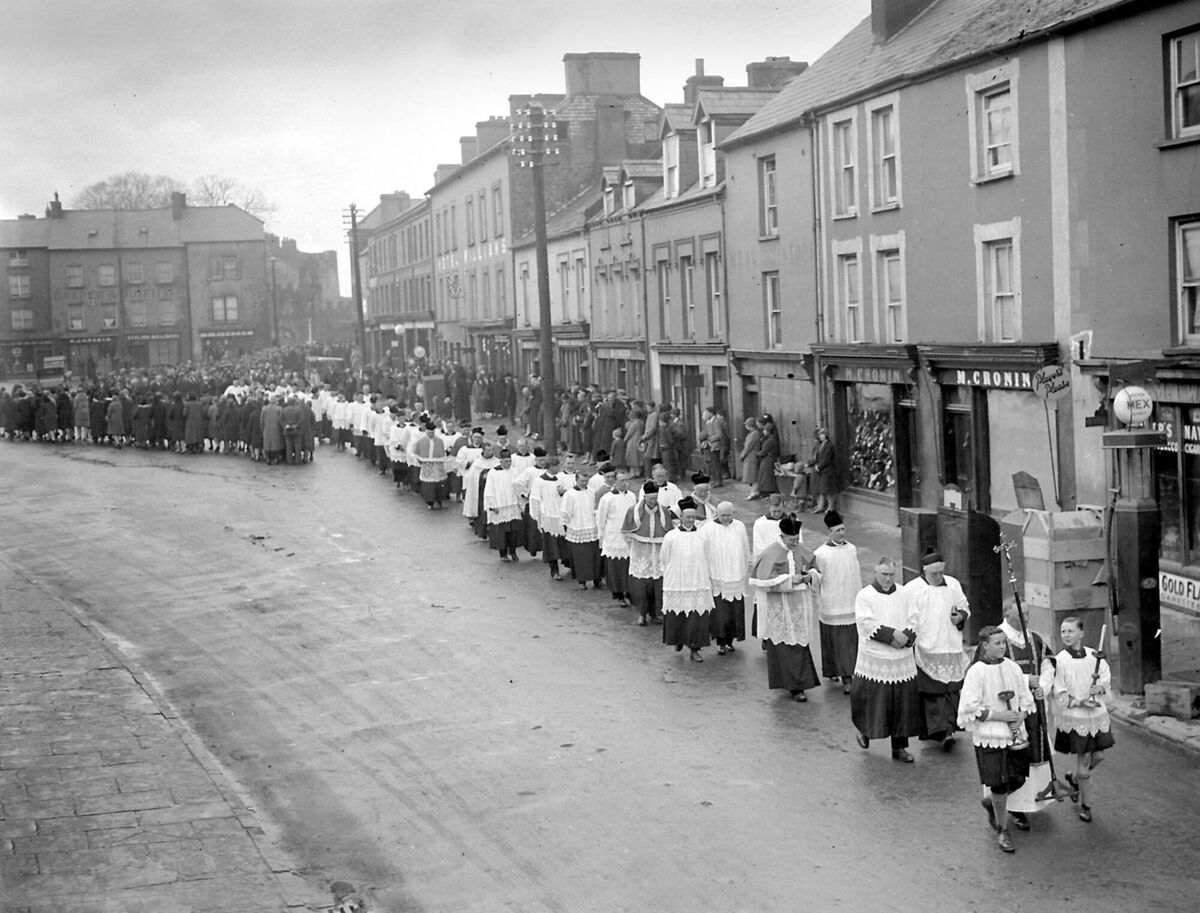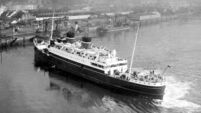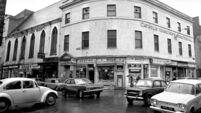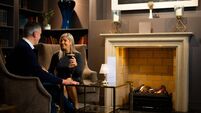Throwback Thursday: Pray tell! Memories of life as an altar boy

Michael Kennefick during his stint as an altar boy, in Whitegate, East Cork. He says: “The Mass was entirely in Latin, which we had learned off by heart”
Well, we did get some lively responses to those stories of tapping phones and fiddling the coin returns in the classic old telephone boxes that are now disappearing from our streets – but not, evidently, solely from our Throwback Thursday column last week.
We got an immediate reply from Joe Burns last Thursday when the pages had only just been published.
“Morning Jo,” said Joe. “Whilst driving to a GP appointment this morning, I got a great laugh from your piece about the tenner! It came out on this morning’s It Says In The Papers on RTÉ1 Radio 1’s Morning Ireland! Well done!”
It’s good to know that we were mentioned there, Joe. Thanks for telling us!
If you don’t recollect that wonderful story about party lines and intervening operators, you can read last week’s Throwback Thursday in the Nostalgia section on EchoLive.ie here.
And following Mick McCarthy’s account last week of a trick played involving an empty coffin, Aidan Vaughan shared this one:
“Young pupils at a nearby school used to get in to the undertakers where bodies had been prepared for family visitation, and put cigarettes into their mouths for a joke,” recalled Aidan.
“The solution? One of the workers there lay in the coffin waiting for the young visitors. They arrived as normal and placed the offending cigarette in his mouth.
“Without blinking an eye, the worker murmured, ‘Give me a light’. The terrified youngsters shot out and across the street!”
Speaking of Mick McCarthy, you will remember he mentioned trying to give music lessons to Rory Gallagher. Of course, we demanded more about this, and he obliged:
“Even though Rory was two or three years older than me, he was extremely quiet, almost humble,” said Mick, “Except that he couldn’t stop ‘fiddling’ on the guitar when I was trying to talk with him! It really was part of him.
“I was only a relatively shy country boy at that time, but, having played in pubs and at weddings/dinner dances, etc, since I was 14, I felt very comfortable talking ‘music or dogs’ with anyone. (The reference to dogs reflects Mick’s life-long involvement with search and rescue canines.)

“Rory mesmerised me because he was able to play anything, from the standard showband or old blues songs to jigs and reels, whereas I would have to spend hours listening and trying to learn these songs.
“I have met, and played with, musicians since, though, who were just as much into music as Rory. I played with a ceili band for a while and the ‘box’ player/leader (Michael Buckley, from Upton) was similar to Rory in his attitude to music.
“When practising in his house, some of the older lads would play a tape of Elvis, or Chuck Berry, and after one listen Michael would tell us to turn it off and he would play those tunes immediately on his five-row Shand button accordion.
“Like Rory, his musical ear, was second to none, and even now, more than 50 years later, I still admire his musicianship.”
Mick continues: “Over the years, I’ve played with some brilliant musicians, international visiting bands in the Opera House, the Arcadia and the City Hall. Irish people should realise that, even though they hear, and see, the singers/bands that are lucky enough to ‘make it big,’ there are ninety-nine more just as good, and better, playing around the country in clubs and pubs all over Ireland.
“Really, for such a small country, we have been lucky, that the likes of Rory, U2, Van Morrison, etc,have ‘made it big’ internationally. That has helped very much to promote Ireland as a great place for music and song.”
Gosh, I wish people were in the habit of filming everyday events back then, Mick! What wouldn’t we all give to be able to see a video of Mick and the young Rory sitting together, Mick explaining how to read music, Rory instinctively and automatically fingering chords on his beloved guitar.
Come to that, this writer wishes she had a photograph of Rory sitting out on the windowsill of the very top floor of St Kieran’s on Pope’s Quay, his legs dangling in space, as he peacefully worked out riffs on his guitar during the lunch break. Alas, I have to make do with the one that is engraved on my memory.
Another Throwback Thursday reader, Micheal Kenefick, was spurred by John Arnold’s column in last Thursday’s Echo about ‘chapel women’ and their duties of cleaning and polishing and general caretaking, to send us his own memories of being an altar boy in the local church at Aghada.
“In the modern world, ‘altar boys’ is politically incorrect and they should be referred to as ‘altar servers’ as girls are now also allowed to serve in church,” points out Michael.
“Yet is only a short time ago that not only were girls barred, but apart from the ‘Chapel Woman’, females risked going straight to the flaming fires of Hades if they as much as put their foot inside the altar rails.
“By a strange quirk of fate, since the pool of servers has doubled, it is not unusual to have the church server-less. If that had happened in the 1950s, Mass would have to be cancelled or at least postponed until help arrived.
“We had teams of six, and we all generally turned up. We did of course love it, which was a good start, and if we loved the regular stuff, imagine the ‘high’ we were on when it came to October Devotions.
“May was good, but October was magic. Young and old in their droves walking from Whitegate to Aghada and back. No requirement for drugs, hard or soft, except maybe a shared fag as the journey was undertaken on pure adrenaline.”
Michael continues: “The ‘new’ Easter Ceremonies, which were in the ’50s, were the only events to surpass the October Devotions. Endless hours of practice and praying for a starring role when the jobs were being doled out.
“Apart from the time spent on the altar serving at Mass or Devotions, there were a myriad of exciting tasks using (and using legitimately) equipment that could only otherwise be used clandestinely; matches, candles, ladders, charcoal, and the thrill to end all thrills – ringing the bell to call the faithful to prayer.
“This required the skill of a carillonneur, not simply to get the bell to peal, but to make it peal with a pull on the rope hard enough to get lifted off the ground, and soft enough to prevent a double ring. Father O’Brien would go mad if there was a double ring as he probably knew that she was being forced and that the ringer was getting a lift into the belfry.
“We used to start a quarter of an hour before Service and stop with five minutes to go, but I think it was Father O’Brien again who changed the starting time to ten minutes and five minutes respectively, thus depriving us of a magical five minutes on the rope.
“Since none of us possessed a watch,” recalls Michael, “we would start for the choir gallery when the sacristy clock showed 15 minutes to go.
“Of course, we had a few vaults over the pews to pass another minute, and as the gallery gang (as in most churches) wouldn’t be the earliest of arrivers, we would have the place to ourselves. Off then to the belfry to get her started, which had to be a few nice slow tugs to get ready for the first gong.
“In order to stop on time, a signal had to be given from the sacristy door by another altar boy, who would be jealous of the good time you were having, even though it might well be his own turn next.
“A brief battle of wits would ensue as he would try and stop you a few seconds early while you ignored the frenzied waving of the hands for ‘just a few more rings’.”
Michael says the other major job which had to be done before Mass, was the lighting of the candles.
“There were six in great brass candlesticks on the highest ledge - three on either side of the Tabernacle - and these were lit from behind the altar from a stepladder. There were four more on the lower ledge, which were lit with a taper attached to a long pole, the other side of which was used to quench them when service was over.
“For Benediction, there were 14 more candles on two sloped candelabra reaching from low to high towards the Tabernacle.

“There were several jobs for Mass, but fewer for devotions - no collections or communion, to mention but two.
“The most important mass job, which was usually claimed by the ‘boss’ (the senior of the six) was Serve High, followed strangely enough by Serve Low, and in third place the bell (the one on the altar this time) which was rung a lot more often then - six times for the Consecration alone.
“Two altar boys stood at the altar rails to take the collection from John Higgins, and Jerry always getting up a little too soon just for the break.
“They would also put up the altar cloth for Communion, which was taken kneeling from the rails, and only at first mass where there would be a few regular fainters as people were fasting from the night before.
“The final big job was assisting the priest at Communion by holding the paten under the chin of the recipient.
“On rare occasions, there might be communion at second mass for just one person, and to this very day I have no idea why.
“The Mass was entirely in Latin, which we had learned off by heart. Nobody in the packed church understood a word, and even if they did, they could not hear as the priest had his back to the congregation and there was no such thing as amplification.
“We knelt all through mass, and as there were no chairs or seats inside the rails, we would sit on the lower step of the altar and rest our elbows on the second step, often through long sermons, especially during the mission.
“At Benediction, we knelt on the marble floor away from the altar with the thurible and incense, but we would willingly have knelt on nails or broken glass to get to swing the thurible!
“The beautiful hymns in Latin, with Danny Mac on the organ and Vera in the choir, have not been bettered since.”
Michael adds: “When we started, with the skin almost scrubbed off our faces, and a surplice whiter than snow, the soutane was touching the ground, and when we left it had climbed to our knees, so I calculate that we would have given about a foot and a half of service.
“On off duty Sundays we would sit in the front row of the Whitegate Gallery, which had the double advantage of a bird’s-eye view of the Aghada altar boys, to ensure they were reminded later of any mistakes; but far more importantly allowed us an opportunity to admire the girls in the Farsid Gallery, one of whom I still haven’t quite forgotten.”
Now. there’s a wonderful detailed reminder of how things used to be at Sunday Mass before everything got trendier.
Any other memories out there? Email jokerrigan1@gmail.com or leave a comment on our Facebook page: www.facebook.com/echolivecork.







